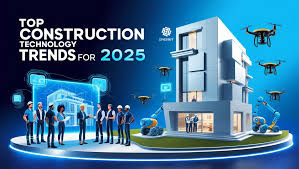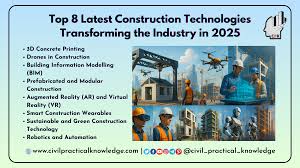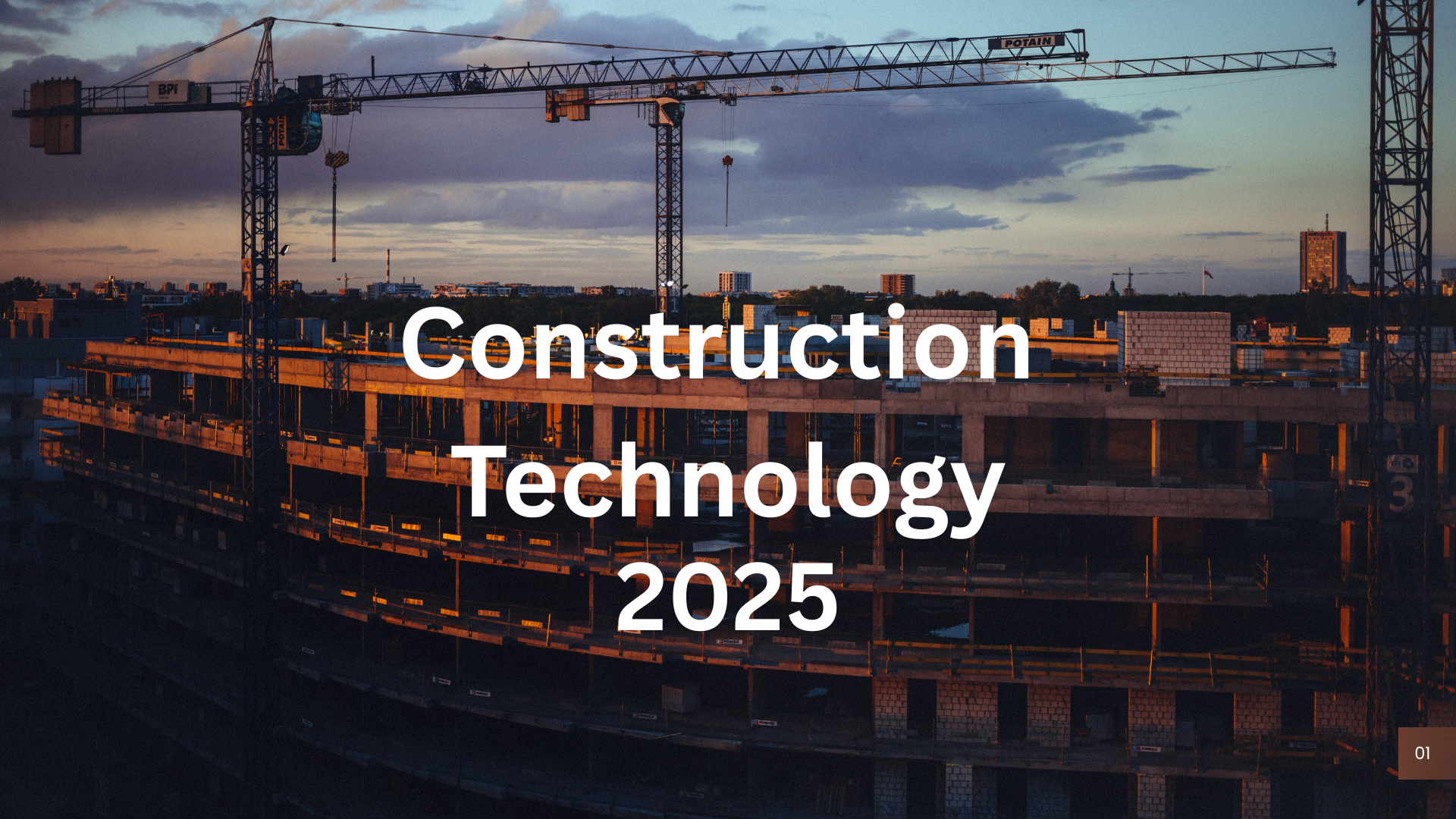Introduction
Have you ever pondered why it takes so long to fix your local road while constructing a skyscraper today seems like something from a science fiction film? Imagine this: In 2025, drones buzz overhead as a construction crew in Dubai 3D prints an entire office building, providing real-time progress mapping. Back home, your neighbor’s home renovation is taking longer than expected because they are using antiquated equipment. That’s the crazy world of construction technology, which is changing the way we build but isn’t yet widely accepted.
Contech, as the hipsters call it, is a broad term that includes everything from self-healing sustainable materials to robotic bricklayers and AI-powered project management. With a predicted 111% CAGR in 3D printing alone by 2028, the industry is embracing technology like BIM and automation more quickly than ever before, according to Deloitte’s 2025 Engineering and Construction Industry Outlook. In a sector beset by delays and overruns, it’s not just about speed; it’s also about safety, sustainability, and cost savings.
In this piece, we’ll explore the true meaning of construction technology, the most popular trends that are upending the industry, and why even your grandmother could benefit from learning about it (hey, all ages are welcome!).
What is Construction Technology?
Construction technology is the key to making buildings smarter, faster, and less likely to fall on your head. It’s not just a fancy buzzword used at tech conferences. Fundamentally, the tools, software, equipment, and inventions used to organize, carry out, and maintain construction projects are referred to as construction technology. It all comes down to combining intelligence and strength, whether on dusty construction sites or in modern digital models.
Consider it the progression from hammers and nails to weather-delayed apps or bricklaying robots that don’t complain about coffee breaks. Construction technology, according to industry experts, includes drones, BIM, data collection apps, and more, all of which are intended to increase productivity and safety. Smart construction tools can be used for small renovations as well as large-scale projects.
But why is this important to everyone, from retirees planning home additions to teenagers aspiring to become architects? Because construction technology improves our everyday lives through safer roads, greener homes, and creative spaces. Who wouldn’t want a home constructed by forward-thinking tech, let’s face it?
Evolution of Building Innovation
Construction technology development is similar to watching a caterpillar transform into a butterfly: slow at first, then amazing. We had pyramids constructed in the past using only manpower and ingenious ramps. As the Industrial Revolution progressed, heavy lifting became effortless thanks to steam engines.
Building innovation is booming right now. By 2025, supply chains will be optimized by AI, and virtual reality will allow you to “walk” through a building before any bricks are ever laid. Cemex Ventures highlights trends like VR/AR and 3D printing as game-changers. The transition from stone tablets to tablets that create stones is funny!
This evolution continues. As sustainable building technology advances, we are constructing buildings that produce their own energy.
Why Embrace Construction Technology Now?
Why is the construction industry sometimes stuck in the Stone Age when your phone can order pizza without you having to do anything? Simply put, although change is difficult, there are enormous benefits. Adopting construction technology now is crucial to maintaining competitiveness; it is not an option.
According to statistics, the construction industry is rapidly digitizing. More use of robotics, digital twins, and BIM is reported by Deloitte. Why? Because without technology, projects typically go over budget by 80%, but efficiency soars when technology is used.
This translates into improved infrastructure for people of all ages. Seniors have access to accessible homes, adults have effective offices, and children attend safer schools. It’s also environmentally friendly because up to 30% less waste is produced by sustainable building technology.

Boosting Efficiency with Smart Construction
It’s like giving your project a brain transplant when you use smart construction. Projects use IoT sensors to track everything in real time, from worker safety to material usage. It’s hilarious until you realize it saves lives to imagine a site where machines communicate with one another to prevent accidents before they happen.
BIM is integrated into programs like Autodesk’s software to facilitate smooth planning. Visit our internal project management tools post for additional efficiency tips.
Remember the humor, too: If you don’t use clever construction, your build may wind up looking like that leaning tower, but not intentionally!
Top Trends in Construction Technology
The year that construction technology becomes widely used is 2025. These developments are revolutionizing the industry, from drones scouting locations to AI forecasting delays. According to Autodesk’s insights, minimizing mistakes and rework is a priority.
Here’s a quick table of top trends:
| Trend | Key Benefit | Adoption Rate (2025) |
|---|---|---|
| AI & Robotics | Automates tasks | 37% |
| BIM | Improves collaboration | 50%+ |
| 3D Printing | Speeds up building | Growing at 111% CAGR |
| Drones | Enhances surveys | High in large projects |
| Sustainable Tech | Reduces environmental impact | 26% investment |
Data sourced from various reports.
AI and Robotics in Action
AI in construction is similar to having a super-intelligent, sleep-deprived foreman. While robotics manage repetitive tasks like bricklaying, it forecasts problems by analyzing data. AI is a top trend for 2025, according to Zoro.
Robots may short circuit in the rain, but ironically, they don’t take lunch breaks!
BIM: The Digital Backbone
Building Information Modeling (BIM) is the 3D blueprint on steroids. It creates digital twins of buildings for better planning. Widely adopted, it’s key in smart construction.
3D Printing Revolution
Is 3D printing used in construction? Indeed, it prints documents just like your desktop printer does. Massive growth is predicted by Exploding Topics. It’s quick and sustainable, making it ideal for low-income housing.
What a conversation starter it would be to tell your friends that your house was “printed”!
Drones for Site Surveys
Drones in building are like eagles with cameras. They survey sites, monitor progress, and spot issues early. Beck Technology highlights their use in preconstruction.
For all ages, it’s exciting tech – kids love the flying aspect!
Sustainable Building Tech
Sustainable building tech integrates green materials and energy-efficient designs. With climate change, it’s crucial. Investment in renewables is at 26%.

Challenges in Adopting Construction Technology
Not all rosy – adoption is slow. McKinsey notes low IT spend at 1-2%. Barriers include cost, training, and resistance.
Humor: Some builders treat new tech like vampires treat garlic!
Overcoming Adoption Barriers
Strategies: Start small, train staff, show ROI. Deloitte shows 37% using AI, up from 26%.
Case Studies: Construction Technology Wins
Real-world wins: A Dubai project used 3D printing to cut time by 50%. Another used BIM to avoid $10M in errors.
These stories show construction technology pays off – literally!
Read more: Digital Construction 🏗️ Setting out and engineering – what’s …
Future of Construction Technology
Anticipate further AI, IoT, and AR/VR integration in the future. According to Boom & Bucket, digital twins will become commonplace.
It means a creative and inclusive built environment for both young and old.
Future predictions in bullet points:
By 2030, robotics will be widely used.
Zero-waste locations using smart technology
AI-generated structures
Maintenance drone fleets
Dominance of sustainable materials
Read more: Everything You MUST KNOW About The Construction Industry …
Summary
In conclusion, construction technology is changing the way we construct our world, from 3D printing cutting down on timelines to AI streamlining processes. In order to keep things effective and environmentally friendly, we have investigated trends like BIM, drones, and sustainable technology. Despite obstacles, adoption is booming; according to statistics, 37% of businesses are utilizing AI, and average businesses are implementing 6.2 technologies. This translates into smarter, safer spaces for people of all ages.
Construction technology is essential whether you’re building a birdhouse or a career. Jump in, try things out, and see the magic happen.
Post your opinions in the comments section! Which trend in construction technology is your favorite?
Read more: What is Communication Technology? Best Guide 2025
FAQs
What is construction technology?
Construction technology refers to innovative tools, software, and machinery used in building projects to improve efficiency, safety, and sustainability. It includes AI, drones, BIM, and more. Adoption is growing, with 91% of pros noting increased use among colleagues in 2024 surveys. It’s essential for modern projects, reducing errors and costs.
Why is construction technology important?
It’s crucial because it boosts productivity in an industry lagging behind others. With labor shortages (440,000 US vacancies), tech like robotics bridges gaps. It cuts waste, enhances safety, and supports sustainability. Deloitte notes faster adoption of BIM and AI, leading to fewer overruns and better ROI.
What are the latest trends in construction technology?
2025 trends include AI for project management, 3D printing (111% CAGR), drones for surveys, and sustainable tech. Robotics automate tasks, while digital twins simulate builds. Cemex Ventures highlights VR/AR for immersive planning, making construction smarter and faster.
How does construction technology improve sustainability?
It promotes green materials, energy-efficient designs, and waste reduction. Tech like IoT monitors resource use, while 3D printing minimizes excess. Investments in renewables are at 26%, helping meet eco-goals and reducing carbon footprints in building.
What challenges does construction technology face?
Main barriers: High costs, training needs, and resistance to change. Only 1-2% IT spend vs. 3-5% average. Surveys show 77% find adoption tough, but strategies like proving ROI help overcome them.

